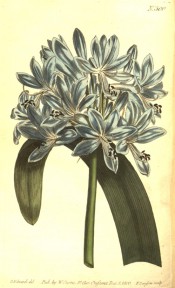Agapanthus praecox Willd.
Half-hardy clump-forming, rhizomatous evergreen perennial with long, strap-like leaves and rounded umbels of deep blue, trumpet-shaped flowers in spring. The species varies somewhat in flower colour and size, number of flowers to the umbel and in overall size. Not surprisingly there are now many garden forms. To 90cm. [RHSE, Hortus, CECB].
Horticultural & Botanical History
Introduced into cultivation in Europe in 1687 and first named Crinum africanum by Linnaeus [Sp.Pl. vol.1, p.292/1753]. It was later placed by L’Héritier in his newly proposed genus of Agapanthus with the specific epithet umbellatus [Sert. Angl. 18/1788]. In 1809 Willdenow described Agapanthus praecox as a species distinct from A. umbellatus [Enumerato Plantarum – Willdenow vol.1, p.353/1809], and this is the name generally used today.
Agapanthus africanus (L.) Hoffm. is a distinct species, not suitable for general cultivation, although often confused with Agapanthus praecox. ‘The remaining two evergreen species, A. africanus and A. walshii, are not suited to cultivation, which is unfortunate because the flowers of A. africanus are a particularly deep, almost navy blue, and the lovely nodding, rather tubular flowers of A. walshii are unusual in the genus. [CECB]. Likewise there is some comfusion in synonymy between the two species, with some of the synonyms given here also applied to africanus.
‘Its root is not bulbous, but composed of many thick fleshy fibres, about a foot long, and near an inch broad; the flowering stem, which is naked, rises to the height of two or three feet, and produces on its summit a magnificent umbel of fine blue flowers, which come forth irregularly during the whole of the year, but more frequently during August to January.’ [BM t.500/1800].
Paxtons Dictionary lists 3 varieties, albiflorus, white; albidus, ‘whitish’; maximus, blue, and the Botanical Register figures a dwarf form, minimus: ‘The present plant is said to have been now first introduced from the Cape of Good Hope. Whether it is specifically distinct from, or only a variety of, the two larger plants of the same name, long and universally known in our gardens, we have no certain means of deciding.’ [BR. f.699/1823]. There are now many garden varieties, varying primarily in stature, foliage or flower colour. ‘The beautiful variety maximus differs in having broader leaves and larger flowers than usual, as well as the centre of the flower being white, and the margin of a deeper blue than the common variety. Since the days when the commerce of the Dutch revealed to Europe the vegetable riches of the Cape of Good Hope, and filled the gardens of Holland with hitherto unknown vegetable forms, the African Blue Lily has been a favourite object of cultivation.’ [OFG f.153/1854].
History at Camden Park
Listed in all published catalogues [B.20/1843]. In horticultural literature Agapanthus umbellatus has been given as a synonym for Agapanthus praecox Willd., Agapanthus campanulatus F.M.Leight., only described in 1965, and Agapanthus africanus (L.) Hoffm. It is almost certain that Macarthur’s plant is Agapanthus praecox Willd., a species well established in the Camden Park gardens today and naturalised throughout Australia [APNI].
Notes
Published Dec 29, 2009 - 05:04 PM | Last updated Jul 12, 2011 - 05:24 PM
| Family | Agapanthaceae |
|---|---|
| Category | |
| Region of origin | South Africa |
| Synonyms |
|
| Common Name | African blue lily, Love flower |
| Name in the Camden Park Record |
Agapanthus umbellatus |
| Confidence level | high |
